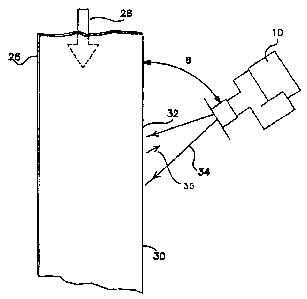Some of the information on this Web page has been provided by external sources. The Government of Canada is not responsible for the accuracy, reliability or currency of the information supplied by external sources. Users wishing to rely upon this information should consult directly with the source of the information. Content provided by external sources is not subject to official languages, privacy and accessibility requirements.
Any discrepancies in the text and image of the Claims and Abstract are due to differing posting times. Text of the Claims and Abstract are posted:
| (12) Patent Application: | (11) CA 2546634 |
|---|---|
| (54) English Title: | APPARATUS AND METHOD FOR MEASURING STRIP VELOCITY |
| (54) French Title: | DISPOSITIF ET METHODE PERMETTANT DE MESURER LA VITESSE DE DEPLACEMENT D'UNE BANDE METALLIQUE |
| Status: | Deemed Abandoned and Beyond the Period of Reinstatement - Pending Response to Notice of Disregarded Communication |
| (51) International Patent Classification (IPC): |
|
|---|---|
| (72) Inventors : |
|
| (73) Owners : |
|
| (71) Applicants : |
|
| (74) Agent: | |
| (74) Associate agent: | |
| (45) Issued: | |
| (22) Filed Date: | 2006-05-15 |
| (41) Open to Public Inspection: | 2007-11-15 |
| Availability of licence: | N/A |
| Dedicated to the Public: | N/A |
| (25) Language of filing: | English |
| Patent Cooperation Treaty (PCT): | No |
|---|
| (30) Application Priority Data: | None |
|---|
A meter (10) is provided for measuring a velocity of a metallic strip or band
(30) moving
along a straight path (26). The meter (10) includes an antenna positioned at a
location
along the path (32)) pointing towards the strip edge at an oblique angle, and
a
transceiver electrically connected to the antenna. The transceiver transmits,
in
conjunction with the antenna, a field of electromagnetic energy of known
magnitude and
frequency and receives reflected electromagnetic energy from material (35)
crossing the
field to produce a signal related to the magnitude and the Doppler-shifted
frequency of
the reflected electromagnetic energy. The meter (10) also includes an
amplifier coupled
to the transceiver, a control unit for calibration, and a central processing
unit. The
central processing unit generates an output signal (4-20mA current loop or
voltage
output) based upon data received from the control unit and a signal received
from the
amplifier, proportional to the measured strip velocity.
Note: Claims are shown in the official language in which they were submitted.
Note: Descriptions are shown in the official language in which they were submitted.

2024-08-01:As part of the Next Generation Patents (NGP) transition, the Canadian Patents Database (CPD) now contains a more detailed Event History, which replicates the Event Log of our new back-office solution.
Please note that "Inactive:" events refers to events no longer in use in our new back-office solution.
For a clearer understanding of the status of the application/patent presented on this page, the site Disclaimer , as well as the definitions for Patent , Event History , Maintenance Fee and Payment History should be consulted.
| Description | Date |
|---|---|
| Time Limit for Reversal Expired | 2011-05-16 |
| Application Not Reinstated by Deadline | 2011-05-16 |
| Inactive: Adhoc Request Documented | 2011-02-17 |
| Deemed Abandoned - Failure to Respond to Maintenance Fee Notice | 2010-05-17 |
| Application Published (Open to Public Inspection) | 2007-11-15 |
| Inactive: Cover page published | 2007-11-14 |
| Inactive: First IPC assigned | 2006-08-20 |
| Inactive: IPC assigned | 2006-08-20 |
| Inactive: IPC assigned | 2006-08-20 |
| Inactive: Office letter | 2006-06-20 |
| Filing Requirements Determined Compliant | 2006-06-13 |
| Inactive: Filing certificate - No RFE (English) | 2006-06-13 |
| Application Received - Regular National | 2006-06-13 |
| Small Entity Declaration Determined Compliant | 2006-05-15 |
| Abandonment Date | Reason | Reinstatement Date |
|---|---|---|
| 2010-05-17 |
The last payment was received on 2009-05-11
Note : If the full payment has not been received on or before the date indicated, a further fee may be required which may be one of the following
Please refer to the CIPO Patent Fees web page to see all current fee amounts.
| Fee Type | Anniversary Year | Due Date | Paid Date |
|---|---|---|---|
| Application fee - small | 2006-05-15 | ||
| MF (application, 2nd anniv.) - small | 02 | 2008-05-15 | 2008-04-28 |
| MF (application, 3rd anniv.) - small | 03 | 2009-05-15 | 2009-05-11 |
Note: Records showing the ownership history in alphabetical order.
| Current Owners on Record |
|---|
| STAN BLESZYNSKI |
| Past Owners on Record |
|---|
| None |